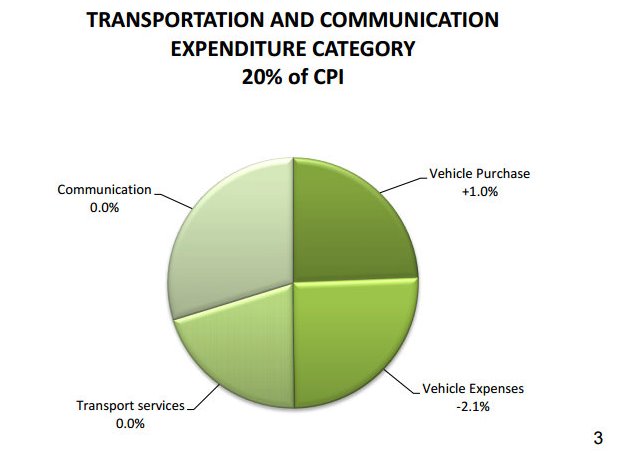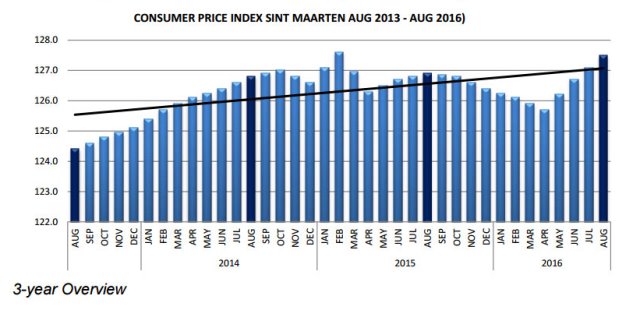~ Prices have increased compared to June 2016 ~
The Consumer Price Index for St. Maarten has increased in August 2016 by 0.6 percent compared to that of June 2016.
When comparing average consumer prices over a 12-month period (August 2015 to August 2016), a decrease of 129.6 percent was recorded compared to the same period one year earlier. The current level of deflation (-0.3%) is comparable to that recorded in January 1986 (-0.3%).
This is evident from the data released by the Department of Statistics (STAT) today.
Price changes between August & June 2016
The Consumer Price Index for St. Maarten has increased in August 2016 by 0.6 percent compared to that of June 2016. The price index recorded in August 2016 is 127.5.

Expenditure Categories
Overall increase in August 2016, three of the nine expenditure categories became more expensive, whilst five became cheaper. Amongst the more expensive were the categories: Food (+0.3%), Housing (+2.0%) and Recreation & Education (+0.6%).
Whereas slight decreases were recorded for the expenditure categories: Beverages and Tobacco (-0.6%), Clothing and Footwear (-0.4%), Medical Care (-2.0%), Transport & Communication
(-0.3%) and Miscellaneous (-0.1%).
Food

Within the expenditure category Food, it can be noted that seven of the nine food groups became more expensive whilst two became less expensive. The following food groups recorded increases: Grain (+0.2%), Meat and Fish (+0.8%), Fats & Oils (+1.4%), Potatoes, Vegetables & Fruit (+0.6%), Pre-cooked dishes (+2.6%), Eating-out (+0.1%) and other food resources (+0.1%). While the food groups, Dairy Products and Sugar and Chocolate became slightly less expensive, -1.9% and -0.8% respectively.
More specifically the following products largely influenced the total price change within the food groups: Grain, was largely influenced by white bread (-2.1%), cakes and biscuits (+4.2%), white rice (+2.3%) and brown rice (+1.9%).
The food group Meat & Fish, was largely influenced by beef steak (-20.6%), pork meat
(-46.3%), Spareribs (+6.8%), goat meat (+5.8%), ham (-5.4%) sausages (+8.7%), shrimps (+14.3%), other fish (+8.6%) and poultry (+0.5%).
The food group Dairy Products was largely influenced by canned milk (+1.7%), cheese (+1.5%), other cheeses (-13.9%) and eggs (-15.5%). The food group Potatoes, Vegetables & Fruit was largely influenced by potatoes (+3.2%), leafy greens (-10.6%), cabbage (-4.5%), tomatoes (+7.7%), frozen vegetables (+4.8%), other vegetables (+9.7%), spices (-1.9%), apples and pears (+4.2%), grapes (-3.4%), other citrus fruit (+30.7%), plantain (-3.3%) other fruit (-11.0%) and raisins (+3.5%).
1 Please note that the pie chart above depicts the share (weight) each food group carries toward the entire Food expenditure category, whilst the percentages indicate the price change within that food group.
Housing

Within the expenditure category Housing, it is noted that four of the five product groups became more expensive while one remained stable. The product groups: Energy expenses, Maintenance of dwelling, Garden maintenance, and Dwelling costs increased by +11.5%, +2.3%, 0.2% and +0.4% respectively.
An increase in the consumer price of electricity by 4.9% and cooking gas cylinders by 48.7% largely influenced the total price change within the product group Energy expenses. The Product group Maintenance of dwelling, was largely influenced by paint (-1.2%), wood (+3.8%), roofing material (+3.5%), pest control (+42.3%) other materials for maintenance of dwelling (+1.5%) and labour cost for maintenance of dwelling (+0.7%).
2 Please note that the pie chart above depicts the share (weight) each food group carries toward the entire Housing expenditure category, whilst the percentages indicate the price change within that product group.
Transport & Communication

Within the expenditure category Transport & Communication one of the four product groups became more expensive, one became less expensive, whilst two remained stable. The product group Vehicle Expenses recorded a price change, namely a decrease of 2.1%. The price change amongst the products car parts (-3.5%), tires (+1.8%), batteries (+12.5%) mufflers (-9.2%), motor oil (-2.8%), gasoline (-6.4%) and diesel (-6.8%) largely influenced this product group.
3 Please note that the pie chart above depicts the share (weight) each food group carries toward the entire Transport & Communication expenditure category, whilst the percentages indicate the price change within that product group.
St. Maarten Consumer Price Index – a Broader Perspective
Though the trend over the past 3-year period depicts increasing consumer prices, we note that prices have steadily declined during the period August 2015 through to April 2016. This is evident in the bar chart below. Significant is the recent sharp increases recorded during the past 5-month period. Over the last 3 years, consumer prices have recorded some volatile developments during the period August 2014 and August 2015, and once again during the course of 2016 similar developments are being observed.

The trend line below indicates that inflation on St. Maarten over the last 3-year period has been declining. This continued decline has now led to a rate of deflation in August 2016 at a rate of -0.3%. The current level of deflation (-0.3%) is comparable to that recorded in January 1986
(-0.3%).

Inflation St. Maarten April 2016
The 12-month average of consumer prices is -0.3 percent lower in August 2016 than a year earlier. This represents a decrease in the inflation rate of 129.6 percent within this period mentioned.
Inflation for the Major Expenditure Categories
Three of the nine expenditure categories account for 69 percent of Household expenditure. These are: Housing (39%), Transportation and Communication (20%) and Food (10%). When looking at the monthly developments of inflation amongst these categories, we note that two of the three have recorded deflation. Notable is the level of inflation recorded for the expenditure category Food has also begun to decline. The monthly developments amongst the three major expenditure categories are illustrated in the bar chart below.































